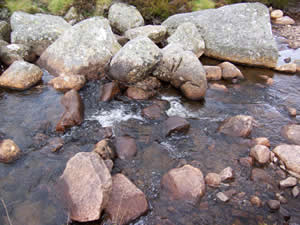 Pathogenic bacteria entering fresh and marine waters represent a major source of environmental pollution and risk to human health and transportability of bacteria through catchments ultimately influences bathing water quality. Bacteria bound to particulate matter may settle and remain within sediment rather than being transported further downstream, however the processes controlling bacterial binding to colloids and sediments are poorly understood. Our research applies conventional and novel analyses to laboratory and field samples and links the findings to transport models. Of particular interest are the uncertainties relating to bacteria-colloid interactions. These can be influenced by bacterial and colloid characteristics (size, surface charge, composition, & structure; strain and metabolic state of bacteria) or environmental factors including rainfall (resulting in changing flow rates, electrolyte dilution, sheer forces) and water chemistry.
Pathogenic bacteria entering fresh and marine waters represent a major source of environmental pollution and risk to human health and transportability of bacteria through catchments ultimately influences bathing water quality. Bacteria bound to particulate matter may settle and remain within sediment rather than being transported further downstream, however the processes controlling bacterial binding to colloids and sediments are poorly understood. Our research applies conventional and novel analyses to laboratory and field samples and links the findings to transport models. Of particular interest are the uncertainties relating to bacteria-colloid interactions. These can be influenced by bacterial and colloid characteristics (size, surface charge, composition, & structure; strain and metabolic state of bacteria) or environmental factors including rainfall (resulting in changing flow rates, electrolyte dilution, sheer forces) and water chemistry.
Our research in this area focuses on these areas and questions:
- Developing and refining flow cytometry techniques for distinguishing particle bound vs. free swimming cells
- Identifying factors affecting E. coli adsorption to clay colloids
- Determining what drives E. coli transport within streams
- Characterising colloid binding profiles of input flows and in-stream samples
Who is working in this area?
- Lisa Avery
- Andy Vinten
|
Updated: 23 Jan 2024, Content by: MC
|

